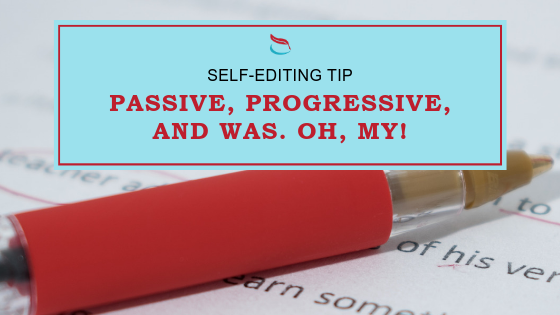|
What’s the deal with was? I was procrastinating from writing this blog post. I was texted by the ACT. Registration was finally open. All those sentences contain the word was. NOT all of those sentences use the passive voice. Twice in two days I saw otherwise knowledgeable people claim that the use of was (or to be in any form) ALWAYS indicates passive voice. It does not. I also saw in those same posts injunctions to delete all instances of the word was, completely rewriting sentences in most cases. These advisers claimed it was necessary to delete, with prejudice, all instances of was to improve your writing. It is not. Yes, sometimes was indicates the passive voice: The table was set (by zombies). (I was texted by the ACT.) Sometimes was is part of the progressive verb tense: I was petting the cat. (I was procrastinating from writing this blog post.) And sometimes was is simply the past tense of the verb to be: I was blonde when I was a child. (Registration was finally open.) When you’re editing your work, you’ll want to review all of these wases and decide on a case-by-case basis whether changing them will improve your writing. Passive voiceLet’s start with the passive voice. Grammatically, the passive voice is formed by using a form of to be + the past participle of the verb. (An oversimplification: the past participle is the “-ed” form of the verb.) The passive voice is used when you don’t know the subject of the sentence (the person or thing performing the action) or when you want to deliberately obfuscate the subject.* Don’t know: The bridge was built 1000 years ago. Obfuscation: The window was broken… One shortcut to determine whether a sentence uses the passive voice is to see if you can append a subject to the sentence and have it still make sense. The internet calls this the “by zombies” rule. The bridge was built 1000 years ago by ancient peoples. (Or zombies.) The window was broken by me. (Or zombies.) Another option is to see if you can flip the sentence around so that the subject appears before the verb: Ancient peoples built the bridge 1000 years ago. I broke the window. The passive voice can be tricky: I was texted by the ACT. looks like it could be an active sentence because of that pesky I, but I in this case is the object of the sentence (not the subject). Flipping the sentence helps show that this is a passive sentence: The ACT texted me. Editing passive voiceWhen you’re editing your fiction, it’s usually best to recast the passive voice to active. Readers have to read the entire sentence to figure out who is doing the action. Because of this delay, they can’t visualize the action. Also, too many sentences in the passive voice too close together make the writing repetitive and tedious. Review all your passive sentences. If the sentence has a clear, knowable subject, try flipping the sentence around. You’ll immediately add a sense of action and movement to your writing. Keep the passive voice when you are intentionally hiding the subject, or when you don’t know the subject, and it doesn’t matter to your story (the bridge builders example). * A note about gendered languageI’m seeing the passive voice used more and more often as a way around gendered language: A backpack was left behind. The passive voice is used in this case to avoid awkward constructions like his or hers, using the singular they, or picking a new pronoun (that isn’t commonly accepted. Even singular they isn’t always accepted, tho it’s gaining ground): A student left behind his or her backpack. A student left behind their backpack. A student left behind zir backpack. As much as possible, you should avoid using the passive voice as a way of avoiding figuring out gendered or gender-neutral language. If you’re in school, check with your writing center to see how they prefer to handle gender-neutral language. If you're working, check with your HR department. Otherwise, just do your best. Gender-neutral language is a bit of a moving target. Singular they appears to be the most common acceptable pronoun at the time of this writing. Progressive verb tenseThe (American) English language has a bunch of verb tenses that indicate when in time an action takes place. The progressive verb tense (also called the continuous tense) indicates: An action that happened over a period of time: I was reading. An action that was occurring when something else interrupted: I was reading when the cat jumped into my lap. An action that is occurring while another action is also occurring at the same time: The cat was drooling on me while I was reading. (Cat 1 is weird…) The progressive tense is formed by using to be + the present participle of the verb (verb+ing), which is why I often advise writers to avoid the “was ‘ing” construction. Why? It goes back to visualization and repetition again. Readers get to was before they get to reading or drooling. It’s hard to visualize was. And when writers overuse the progressive, all readers get to read is was. The progressive also tends to create a rhythm when you use it to show interrupting action, which also gets repetitive and boring: I was going to the store when it started to rain. It was raining so hard, I got soaked. I was dripping on the carpet when I finally got home. I think we writers overuse the progressive because it’s often the verb tense we use when telling stories to our friends and family. Or, at least, when I hear my son tell stories, it’s the progressive verb tense that gets the most play. I also see writers overuse progressive when they describe settings: The flag was standing in the corner. The vase was resting on the table. It was raining. Bonus: the progressive tense comes in all flavors: Present: It is raining. Present-perfect: It has been raining. Past: It was raining. Past-perfect: It had been raining. Future: It will be raining. Editing the progressive tenseJust like with the passive voice, I do recommend switching progressive tense to something else (simple past or present, typically, depending on what verb tense you use for the rest of the novel), especially with description: The flag was standing in the corner. The flag stood in the corner. The vase is resting on the table. The vase rests on the table. It was raining. It rained. I think it’s important to keep the progressive tense in the instance you are indicating one action interrupting another: I was writing a letter to you when the messenger arrived with new mail. Otherwise, you can often switch verb tenses with no loss of meaning. Switching improves the variety in your sentences and improves the readers’ ability to visualize your action. Sometimes was is just to be...Sometimes was is simply the past participle of the verb to be: I was blonde when I was a child. To be is a verb that shows a state of being. It is also called a linking verb: a verb that joins the subject and some condition of that subject: I was young. My sister was taller. Cat 1 is black. When using the verb to be, you are writing about a condition. There is no action in these sentences. Too many of these sentences too close together will be… wait for it… repetitive and tedious. Editing for stronger verbs than to beSometimes a simple statement of being is all you want, so read those wases carefully and decide whether you need that existential statement, or whether you can recast the sentence to something active: Cat 2 was afraid. Cat 2 feared the fireworks. My sister was taller. My sister grew taller than me when she was 10. If you find you truly need all those was sentences, consider rearranging passages to avoid repetition. When I'm doing the editing In a developmental edit (or manuscript critique) I don’t make any changes to any of your wases, regardless of which was you are using. A dev edit is focused on a much bigger picture than your wases: like does your plot make sense? I do make a note in your editorial letter alerting you to how you may be overusing was, and providing examples as to how to fix it. (Or, in future, maybe you’ll get a link to this post!)  In a line edit, I will offer suggestions to change passive voice to active voice, and progressive tense to simple past (or present, whatever your primary verb tense is). I will offer suggestions for how to rearrange sentences when the wases are necessary but repetitious. I don’t change ALL wases indiscriminately. As I read (carefully!), I make judgement calls for each instance.  A proofread is a time to dot the is and cross the ts to get the manuscript ready for publication. By the time you’re doing a proofread, you are typically looking only for egregious errors. You absolutely want to ensure you don’t introduce NEW errors while trying to fix something that doesn’t necessarily need fixing. Using the passive voice and progressive verb tense are not errors; they are style choices. I am unlikely to change these in a proofread unless things start to feel really repetitive. Fixing passive voice involves flipping sentences and assuming the subject if it isn’t already written in to the sentence. I won’t fix passive voice in a proofread. Changing the progressive tense is often simple and doesn’t introduce any large changes (which can introduce errors). I’m likely to contact you to see if you want me to make those changes, but otherwise, I won’t make changes to the progressive tense either. And when was is simply to be? Again, that’s a style choice and not an error. I won’t make changes to those sentences either.
0 Comments
Leave a Reply. |
About ValI read, and then I tell you about what I've read. Whether you want to hear about it or not... Categories
All
Archives
July 2019
|



 RSS Feed
RSS Feed
